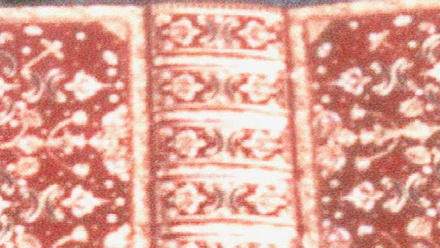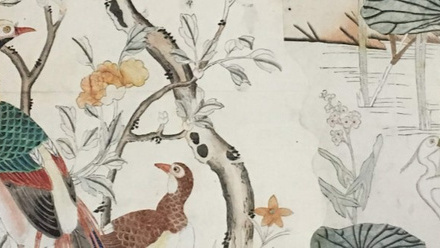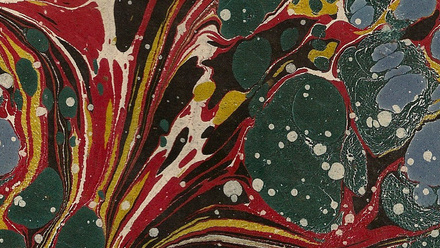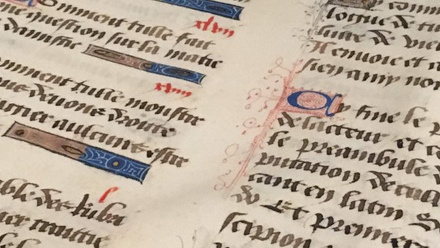The Icon Heritage Science committee curated a series of live streamed webinars exploring contemporary heritage science case studies and practices as part of the Conservation: Together at Home Webinar Series. If you have any ideas about events that you would like to organise, please get in touch with the committee.
Wednesday July 22nd, 4pm BST (Online)
Bhavesh Shah, Scientist at Victoria and Albert Museum
Introduction to R and Data Science
Analysing and presenting data to inform practical solutions is a challenge for any operational preventive conservator or scientist. Data science is a growing field and free data-driven tools such as R can be used to go from data to interactive reporting tools and new insights. This will be a brief, and hopefully gentle, introduction to how R can be used to analyse the types of data typically encountered for collections care.
Wednesday July 15th, 5pm BST (Online)
Michał Łukomski, Head of Preventive Conservation Research at the Getty Conservation Institute
Monitoring micro-changes in historic objects to support strategies for indoor climate management
Responsible management of indoor environments in museums is currently in the spotlight of cultural heritage institutions worldwide. There is general consensus in the museum community that reducing energy consumption has economic, ecological, and ethical benefits.
Since the safety of collection is the foremost priority, new climate control strategy should be scrutinized by response of objects. Recently, the GCI developed methodology employing Acoustic Emission monitoring which allows the progress of micro-fractures in objects to be directly recorded. As a consequence, AE can be used to detect physical changes in objects induced by exposure to their real-world environments and, hence, can support the assessment of adopted strategies for the museum indoor climate management.
Wednesday July 8th, 4pm BST (Online)
National Heritage Science Forum
Building a Skilled and Diverse Heritage Science Community
One of three key themes in the Strategic Framework for Heritage Science in the UK is the development of a skilled and diverse heritage science community. Over the past year, members of the NHSF working group assembled under this theme have been scoping partners, methods, and opportunities to begin addressing this critical priority. At this joint NHSF/ICON HS meeting, we invite two speakers to discuss opening up heritage science to the public through citizen science and strategies to diversify our community. We also invite attendees to contribute ideas and comments on this theme at our timely discussion.
Wednesday June 24th, 4pm BST (Online)
Matija Strlic, Professor of Heritage Science at University College London and Professor of Analytical Chemistry at University of Ljubljana
The European Research Infrastructure for Heritage Science (E-RIHS)
Much could be gained from research that is openly shared, as well as from research that is collaboratively developed. The European Research Infrastructure for Heritage Science (E-RIHS) will specifically promote the sharing of facilities where research is carried out – whether scientific laboratories, conservation workshops or art history research departments. Namely, investments into unique research facilities and expertise are much better justifiable if access to such facilities is open to external researchers. Many such facilities already exist and operate nationally and in order to reduce the risk of duplication, E-RIHS will be developed into a distributed infrastructure. This way, excellent facilities will pool some of their operational time to enable research to be carried out internationally and collaboratively, with lean central management. E-RIHS, including its UK node, E-RIHS.UK, is still actively developing and collaboration is actively promoted across the spectrum of heritage research.
Wednesday June 17th, 4pm BST (Online)
Susan Braovac, archaeological conservator in the research project Saving Oseberg at the Museum of Cultural History & Fabrizio Andriulo, post-doctoral fellow in Saving Oseberg
Applying alkaline nanoparticles to deacidify alum-treated wood
Conservation of waterlogged archaeological wood using alum salts (potassium aluminum sulfate, ammonium aluminum sulfate) was a method used in the past to treat highly degraded wood. It was used on the Viking Age wooden finds from Oseberg, recovered in 1904 near Tønsberg, Norway. Today this wood is very acidic (pH ≤ 2), mainly due to the acid absorbed during the alum treatment. High acidity has caused the wood polymers to undergo a slow degradation over time. In order to slow down degradation, the research project Saving Oseberg investigates retreatment methods for these finds. In some cases retreatment cannot undergo water-based methods. For such objects, we are currently testing alkaline nanoparticles (calcium hydroxide in isopropanol) to deacidify the wood. We present a background of the alum method, facts about calcium hydroxide nanoparticles and show ongoing practical work using these.
Wednesday June 10th, 4pm BST (Online)
Caitlin Southwick, Founder and Executive Director of Ki Culture and Sustainability in Conservation
Sustainability and Cultural Heritage: Our Past and Our Future
Sustainability is a global issue. As realities surrounding climate change and social injustice become more apparent and hit closer to home, people are ready to do something about it. But what does cultural heritage have to do with climate change? How do museums impact social justice? Why do conservators need to learn how to think green in their practice? This webinar will outline what sustainability means to cultural heritage and what unique opportunities the sector has to engage with and promote sustainability – resulting in holistic change and contributing to a sustainable future for all.
You can watch Caitlin's webinar here
Wednesday June 3rd, 5pm BST (Online)
Hayley Simon, PhD student at the UCL Institute of Archaeology
Corrosion and conservation of the Mary Rose cast iron cannon shot
This talk looks at the collection of 1,200+ cast iron cannon shot from the shipwreck of King Henry VIII’s flagship the Mary Rose (c. 1545). From their formation and burial, through to their excavation, conservation and storage, this presentation will examine how the artefacts have changed over time. Using a combination of lab- and synchrotron-based analysis methods, an overview of the material and recent experiments will be given to gain new insights into the chemistry of marine iron corrosion and the impact of different conservation approaches on the reaction.
You can watch Hayley's webinar here
Wednesday May 27th, 4pm BST (Online)
Dr Josep Grau-Bové, lecturer in the Institute for Sustainable Heritage, University College London
Using online and open apps for preventive conservation
Online apps for preventive conservation are proliferating in the web. For free and with a few clicks it is possible to analyse humidity and temperature data, estimate pollutant concentration indoors, predict dust deposition rates, and many other tasks, basic and advanced. Current research projects (such as the developments around IPERION-HS and ERIHS, the European Research Infrastructure for Heritage Science) will accelerate the creation of new online platforms and improve their capabilities. In this talk, I will provide an overview, with practical demonstrations, of some of the best available online tools, and present a blueprint for future developments.
You can watch Josep's webinar here
Wednesday May 20th, 4pm BST (Online)
Carl Heron, Director of Scientific Research, British Museum
100 years of Scientific Research at the British Museum
I’m aiming to present, in 30-40 minutes, a snapshot of 100 years of Scientific Research at the British Museum. In 1920, a small laboratory was established following an enquiry into the condition of objects, largely as a result of inadequate storage during the First World War. From this humble beginning, conservation and scientific investigation developed into the significant core activities evident in 2020. This inexhaustive and rather selective presentation will highlight some examples from the annals of the department. I will end by looking forward to the period ahead.
You can watch Carl's webinar here
Wednesday May 13th, 4pm BST (Online)
Dr Anita Quye, Senior Lecturer in Conservation Science & Head of History of Art, University of Glasgow
Creating constructive pathways to aid ethical sampling decisions in scientific research for cultural heritage
In January 2019 the Icon Heritage Science Group launched new boundary-pushing ethical sampling guidance for decision-making when removing and using material from heritage objects and sites for scientific research. Underpinned by multiple perspectives and shared understanding, this guidance offers a constructive pathway from initial sampling thoughts to project end and beyond, developed from extensive national and international consultations with a range of interested parties. In this webinar, Anita takes us through the guidance and shows how it can be put into practice through personal case studies where constructive ethical thinking and discussions have helped navigate crossroads in sampling decisions.
You can watch Anita's webinar here
Wednesday May 6th, 4pm BST (Online)
Dr Katrien Keune, Head of Science, Rijksmuseum
Metal Soaps in Art: from first observations towards a deeper understanding
Old master paintings as well as modern and contemporary art are subjected to changes from the moment they have been made. Discoloration, increased transparency and darkening, crumbling of the paint, paint delamination and loss: these are just some of the degradation phenomena encountered on oil paintings. This presentation focusses on the wide-spread degradation phenomena that is related to pigment-oil binder interactions, which are metal soaps. Metal soap related defects are observed in paintings by amongst others Rembrandt van Rijn, Johannes Vermeer and Piet Mondrian. Approximately 70% of paintings in museum collections are affected by metal soap-related degradation phenomena.
You can watch Katrien's webinar here
Wednesday April 22nd, 4pm BST (Online)
Prof Eleanor Schofield, Head of Conservation and Collections Care, Mary Rose Trust
Where the arts meet science: Keeping the Mary Rose shipshape
The Mary Rose, a flagship of Henry VIII’s, sank off the coast of Portsmouth in 1545. Rediscovered in the 1960s, the following years saw the excavation of over 19,000 objects, culminating in the excavation of the hull in 1982. Materials vary from leather, wood, human remains to iron, bronze and lead, with items varying in size from minuscule dice to gun carriages capable of transporting 2-3 tonne cannons. The conservation techniques and strategies employed over the last three decades will be discussed, alongside new materials and methods being developed to ensure the long term protection of this important cultural heritage.
You can watch Ellie's webinar here
9th October 2018
Excel Training for Effective Data Management
National Trust Office, London
A training course on Microsoft Excel to help ensure conservators have the skills to efficiently manage their scientific data. The course will be run by Andie Mills from the IT training hub, a professional training company who aim to give participants confidence in Excel and how to use Excel’s features correctly to improve efficiency, leaving more time to concentrate on important tasks, and less time battling with the software. The course will be pitched at an Intermediate to Advanced level, therefore delegates should be familiar with Excel and able to create, format and structure spreadsheets. Ideally have experience in creating basic statistical functions and be able to create a simple chart.
20th April 2018
Introduction to Colour Science and Colour Measurement
Education Room, Charlecote Park, National Trust, Charlecote, Wellesbourne
This one day workshop will provide an introduction to colour science and colour measurement for conservators and conservation scientists who need to use colour measurement as part of their conservation practice or research. Participants will need to have a good general science background, but only a little knowledge of colour science, if any. The day will include the opportunity to use Konica-Minolta spectrophotometers to undertake colour measurements on a range of materials and surface types. Course participants may bring their own samples for colour measurement if they wish. The workshop will be led by Dr Lindsay MacDonald, Honorary Professor at the Faculty of Engineering Sciences, University College London. Dr MacDonald has over 30 years of experience in colour science, and is a co-author of ten books on the subject, including Digital Heritage: Applying Digital Imaging to Cultural Heritage. He is a Fellow of four professional societies, and a former chairman of The Colour Group (GB).
18th April 2018
The role of portable X-ray fluorescence (pXRF) in Heritage Science
Glasgow University Archaeology Department, Gregory Building, University of Glasgow
Portable X-ray Fluorescence Spectroscopy (pXRF) has become one of the most widely available analytical techniques at universities, museums and heritage organisations. pXRF has many applications in conservation, archaeology and heritage science but also presents challenges in how best to capture, interpret and present the resulting data. This event will be presented by Dr. Richard Jones and Dr. Effie Photos-Jones of Glasgow University who will share their expertise in the use of pXRF in the context of Heritage Science on materials such as metals, ceramics, vitreous materials, lithics and paintings. A practical/demonstration session with pXRF equipment as well as opportunities for questions and discussion will be included in the program.
11th September 2017
Historic document analysis using p-XRF: Pitfalls and Possibilities
The National Archives, Kew, Richmond
Portable X-Ray Fluorescence Spectroscopy (pXRF) has become a widely used analytical tool in Heritage Science and Conservation but the particular challenges and advantages of the technique for analysis of documents and archival collections are not often highlighted. Portable XRF instruments are increasingly available at many libraries, archives, universities and other institutions and conservators or heritage scientists are often asked to employ the technique to answer specific questions. The wide variety of pXRF equipment and software available, together with the complexities of acquiring and interpreting analytical data from historic documents can be challenging to navigate. This workshop is primarily intended for conservators and heritage scientists who have analysed or will soon analyse historic documents using pXRF. It is held in cooperation with the Icon Book and Paper Group and hosted by The National Archives, Kew and will offer presentations by four guest speakers with experience in pXRF analysis and its application to documents, opportunities for group discussions among participants, and hands-on demonstrations of pXRF analysis.
16th August 2017
Building Conservation Science at Heriot Watt University
Centre of Excellence in Sustainable Building Design, Heriot-Watt University, Edinburgh
The application of heritage science to buildings is the focus of this one day event, hosted at Heriot Watt University, Edinburgh. Speakers from academia and industry will discuss recent research activities that have led to evidence-based conservation of historic building materials such as stone, lime and glass. In addition, attendees will be invited to a tour of the new Lyall Centre to view the petrography laboratory.
Friday 24 February 2017
Scanning Electron Microscopy theory & practice with a portable Hitachi TM3000, SEM
CSI: Sittingbourne, The Forum, Sittingbourne, Kent
Practical sessions with SEM examination of archeological and historic samples; and a visit to CSI: Sittingbourne public access conservation lab and The Forum Heritage Hub. Participants will receive general theory and practice with a Hitachi TM3000 low vacuum SEM, and illustrations of how it has been employed for public engagement and archeological conservation at CSI: Sittingbourne (IIC Keck Award winner 2012). Opportunity for examination of selected participants’ samples and discounted future bookings for the ‘CSI: Sittingbourne/RLAHA shared use SEM’ included. The shared use
SEM was purchased through funds donated by the Clothworkers Foundation.
Monday 9th January 2017
Mary Rose Trust conservation
Mary Rose Trust, Portsmouth
A chance to see the newly renovated Mary Rose museum in Portsmouth Historic Dockyard. A guided tour of the museum will take place, incorporating some behind the scenes aspects. A selection of talks from conservators and scientists who have contributed to the Mary Rose project will follow.
Thursday 17th November 2016
Bodleian Libraries and Hyperspectral Imaging
Weston Library, Bodleian libraries, University of Oxford
The Bodleian Libraries set up Heritage Science just over three years ago in acknowledgement of an increasing demand for analysis and other scientific support. Of particular interest is Raman spectroscopy which is being 'borrowed' from Durham University, and a hyperspectral Imaging system. There is a very small laboratory housing this equipment but demonstrations of both will be
possible to a small audience. There will also be a demonstration of ENVI software which is being used to interogate the hyperspectral data for both materail identification and revealing hidden texts. The laboratory is within the totally upgraded Weston Library (Previously New Bodleian) and a tour of the Exhibition spaces, Reading Rooms, centre for Digital Scholarship and public spaces can easily be arranged.
Friday 9th September 2016
Micro-fading Workshop
Institute of Sustainable Heritage, University College London
Micro-fading is a fast and cost effective accelerated light aging technique developed by Paul Whitmore from Carnegie Melon University. It is increasingly being used by museums as it is particularly useful for establishing the light sensitivity of individual objects where their chemical compositions or fading history is not known. Different MFT systems and their applications will be describe. A training session and demonstration of the MFT system developed by Jacob Llewelyn Thomas will follow. Participants will be invited to bring in their own objects to fade as a starting point for discussions on challenges regarding objects of different materials with different surface properties. Fading with LED light will be demonstrated.




